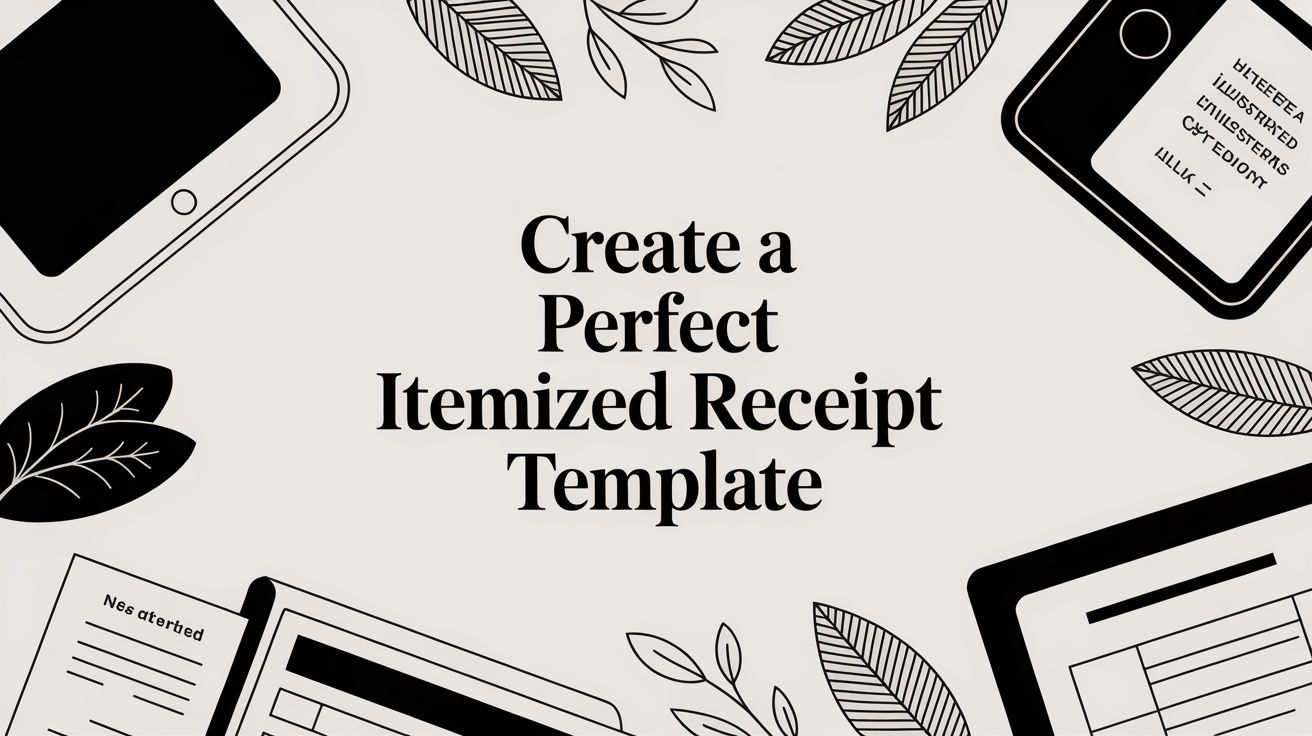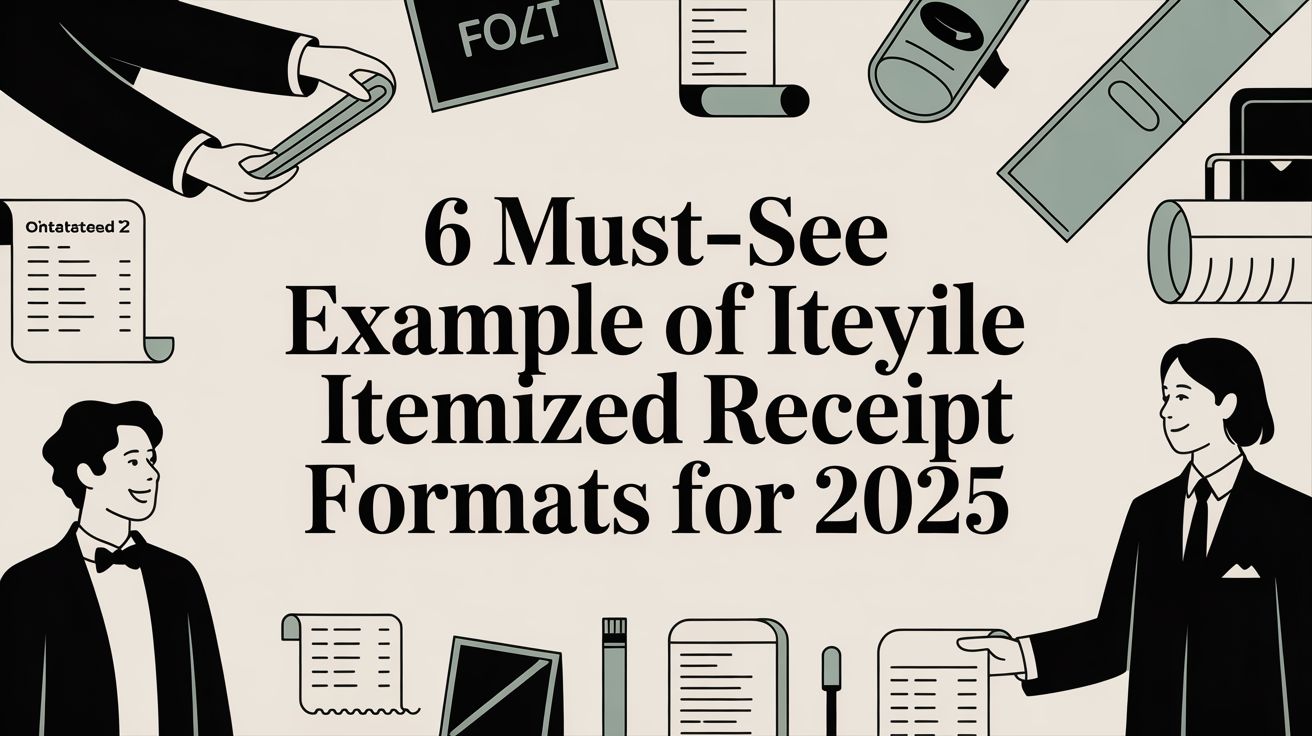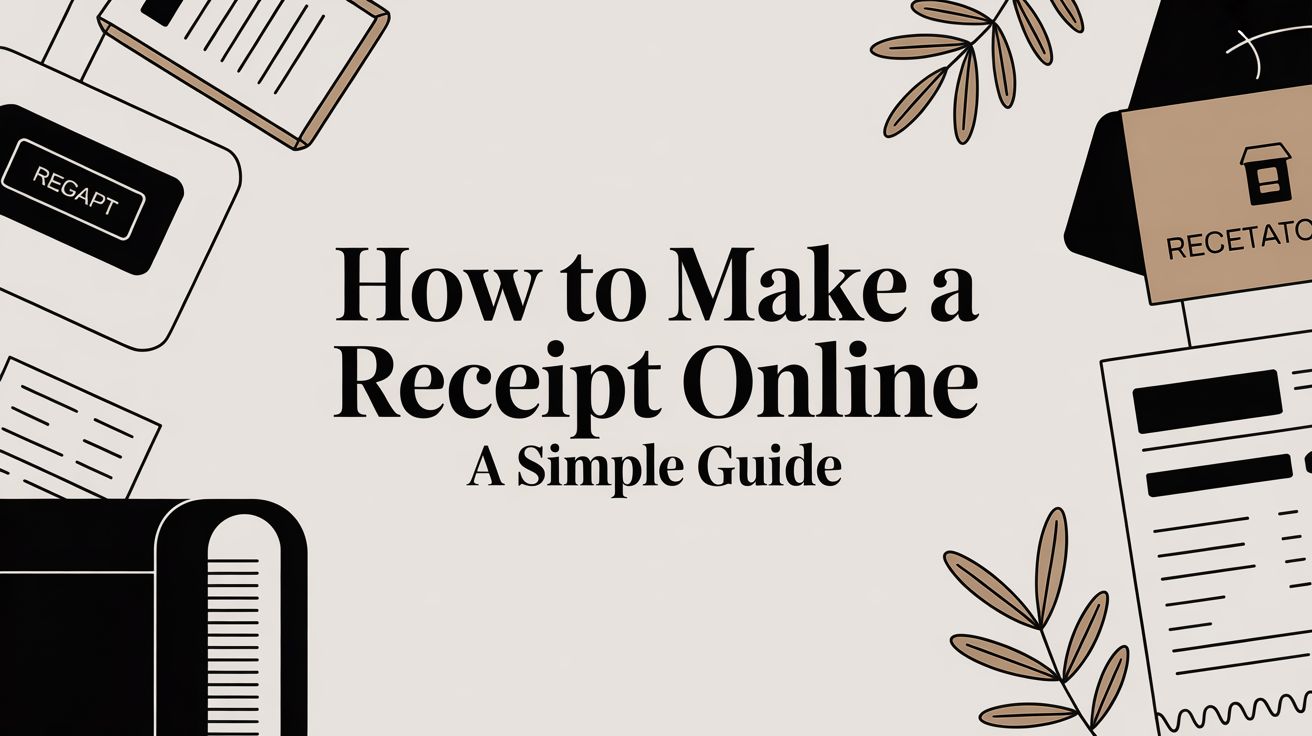
How to Make a Receipt Online a Simple Guide
Creating a receipt online is surprisingly fast. All you really do is pick a template, pop in your details, list what you sold, and download the finished PDF. The whole thing can be done in just a couple of minutes, leaving you with a clean, professional record of the sale.
Why Digital Receipts Are a Game-Changer
Ditching paper receipts for digital ones isn't just about saving trees—it’s a smart move for any business that wants to look sharp and stay organized. When you send a client a crisp, branded digital receipt, it instantly shows you're on top of your game. It makes the whole transaction feel more polished and legitimate.
But it goes deeper than just looking good. Think about the headache of manual bookkeeping. No more digging through shoeboxes filled with faded paper slips. With digital records, your entire sales history is organized, searchable, and ready to go whenever you need it, whether you're answering a customer question or getting your tax documents together.
Make Your Business Run Smoother
The efficiency boost is real. You can generate and email a receipt in seconds, right from your laptop or even your phone. This means you often get paid faster, and your customer gets immediate confirmation of their purchase, which they always appreciate.
For freelancers and small business owners, our time is our most valuable currency. Automating receipts frees up hours every single month that you’d otherwise lose to paperwork. That's more time you can spend actually running your business.
This shift isn't just a niche trend. The global digital receipts market was valued at $1.73 billion in 2024 and is expected to hit $9.14 billion by 2035. That explosive growth shows just how many businesses are seeing the light. You can dive deeper into the numbers in the digital receipts market report on MarketResearchFuture.com.
The Real-World Benefits of Going Digital
- Look More Professional: A clean, digital receipt makes a great impression and builds trust.
- Keep Better Records: All your transactions are organized, secure, and easy to find come tax season.
- Happier Customers: Clients love getting a convenient digital copy they can't lose.
- Save a Ton of Time: Cut down dramatically on the time you spend shuffling paper and doing admin work.
Finding the Right Online Receipt Maker
https://www.youtube.com/embed/2PRJNAqKiaE
With so many tools out there, picking the best way to make a receipt online really boils down to your specific needs. Are you a freelancer who just needs a single receipt once a month, or are you running a small shop with transactions happening all day long? What works perfectly for one is often total overkill for the other.
For one-off needs, simple and free generators are your best friend. They let you whip up a professional-looking receipt in minutes, no sign-ups or commitments required. If you're creating receipts more regularly, you’ll want a platform that at least lets you save a template and add your logo.
The shift to digital is huge. The online receipt generator market is expected to jump from $1.28 billion in 2024 to almost $5 billion by 2032. You can dig into the numbers with these market insights on BusinessResearchInsights.com.
Key Features to Look For
When you start comparing options, it's easy to get sidetracked by flashy features. My advice? Focus on what will actually save you time and headaches.
Here’s a quick checklist of what really matters:
- Customization: Can you easily pop your logo on it and match your brand colors?
- Automatic Calculations: Does it do the math for you on taxes, discounts, and totals? This is a non-negotiable time-saver.
- Export Options: Can you download a clean PDF or, even better, email it directly to your customer?
- Template Variety: Does it have different layouts? Sometimes you need a detailed invoice, other times a simple generic POS receipt is all you need.
This little decision tree sums it up perfectly—the choice between old-school paper and a modern digital solution is pretty clear.
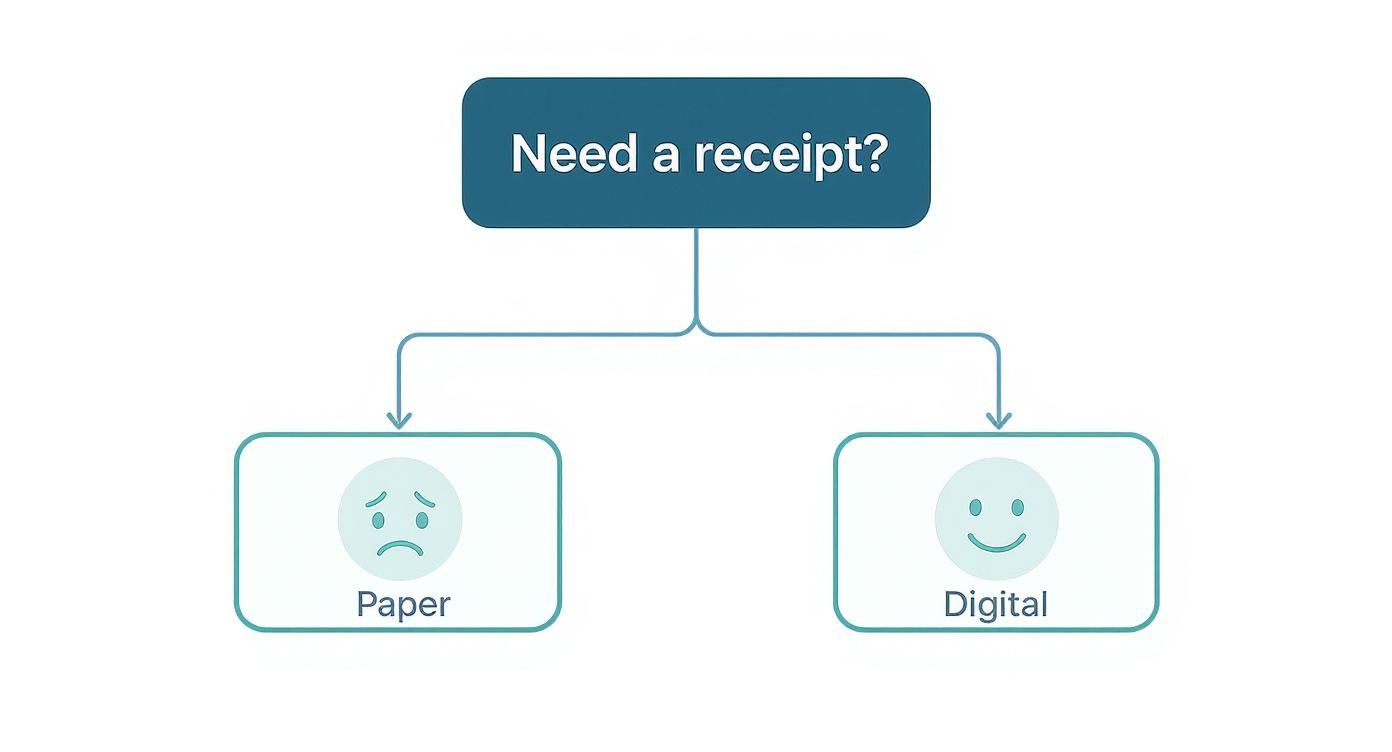
As you can see, for almost every situation today, a digital receipt is the smarter, more practical way to go.
Here's my personal take: always prioritize simplicity and speed. A tool that lets you create and send a perfect receipt in under a minute is far more valuable than a clunky, complex system loaded with features you'll never touch.
Feature Comparison of Online Receipt Tools
To help you decide, here’s a quick breakdown of what you can generally expect from the different types of tools available.
| Feature | Free Generators | Freemium Tools | Paid Invoicing Software |
|---|---|---|---|
| Basic Receipt Creation | Yes | Yes | Yes |
| Logo & Branding | Limited or None | Basic Customization | Full Customization |
| Save Customer Info | No | Yes (Limited) | Yes (Full CRM) |
| Recurring Invoices | No | No | Yes |
| Reporting & Analytics | No | Basic | Advanced |
| Best For | One-off or rare use | Freelancers, small biz | Growing businesses |
Ultimately, the best receipt maker is the one that slides right into your existing workflow without causing friction. I always recommend trying a few free options first. See which one feels the most intuitive and natural to use before you even think about paying for a subscription.
Building Your First Professional Receipt
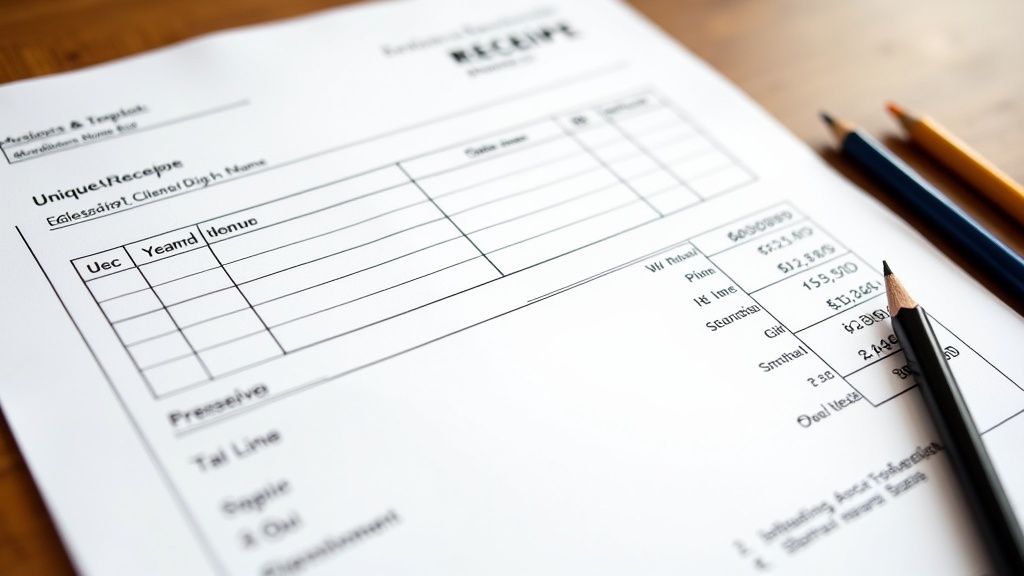
Alright, enough theory. Let's get our hands dirty and actually build a receipt. The idea is to create something that not only looks professional but is also clear, accurate, and holds up for your records. Most online receipt tools, even the free ones, have a pretty straightforward and similar workflow.
You'll start with the basics: your business name, address, and contact info. Right after that, you'll plug in your client's details. Nailing these two sections is the foundation for a polished, trustworthy document.
Adding the Essential Details
Every receipt absolutely needs a unique identifier. Call it a receipt number or an invoice number—it doesn't matter, as long as it's unique. This little number is a lifesaver for your bookkeeping, preventing duplicates and making it a breeze to find a specific transaction if a customer ever calls with a question.
I see a lot of people just go with a simple "001, 002, 003" system. A much better practice is to use a prefix tied to the client or project, something like "SMITH2024-001." Trust me, you'll thank yourself for this extra bit of organization come tax time.
Next up is the date of the transaction. Most tools will automatically populate today's date, but you can always change it if you're creating a receipt for a payment made in the past. These fields are completely non-negotiable for a valid proof of purchase.
Itemizing Products and Services
Now for the heart of the receipt. This is where you clearly list every single product or service the customer paid for. Vague descriptions are your enemy here; be specific to avoid any confusion or disputes down the road.
For each line item, make sure you include:
- Description: Be crystal clear. Instead of just "Consulting," try "Social Media Strategy Consulting (5 hours)."
- Quantity: This could be the number of items or, like in the example, the number of hours.
- Price: The cost per item or per hour.
The tool will do the math for you, calculating the subtotal for each line, which sets you up for the final amount. If you want a fast and easy way to generate your first receipt, a simple online tool is the way to go. It handles all the calculations, so you can just pick a template, fill in the details, and have a finished document in minutes.
The last step is to apply any adjustments. If you need to add sales tax, you'll enter the percentage. If you offered a discount, you can plug it in as a fixed amount or a percentage. The platform automatically calculates the final grand total, saving you from any manual math headaches.
Making Your Receipts a True Reflection of Your Brand
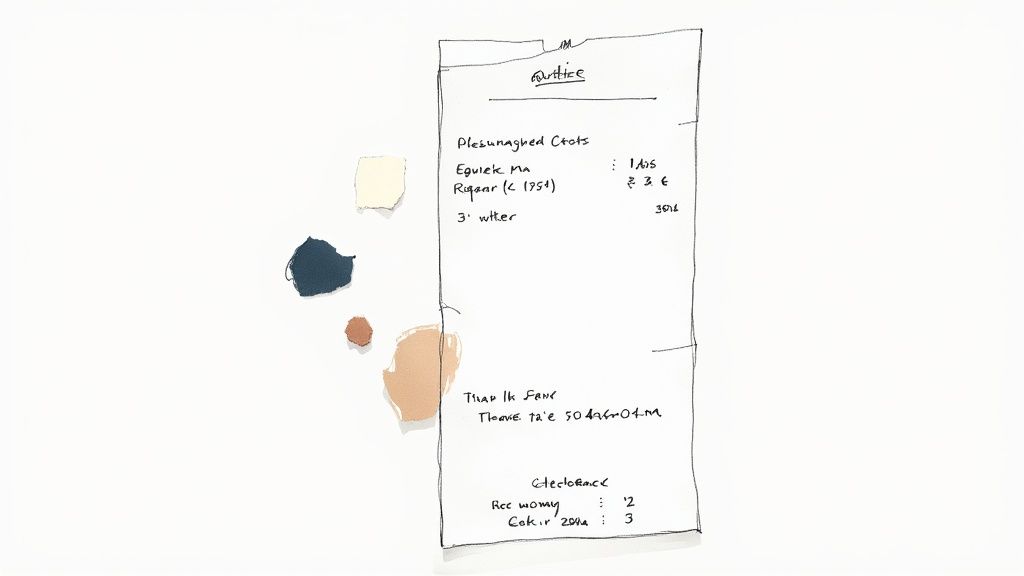
Think of your receipt as the last handshake you have with a customer. It's so much more than a simple proof of purchase; it's a final chance to leave a great impression and reinforce your brand's identity. A generic, black-and-white slip of paper just doesn't cut it anymore.
The easiest win here is adding your logo. This is a non-negotiable. Most online receipt tools have a simple upload button that places your logo front and center. That one small change instantly turns a forgettable document into something that’s clearly yours.
Small Touches That Make a Big Impact
Once your logo is in place, don't stop there. Aligning the receipt's color scheme with your brand creates a seamless experience. If your website uses a specific shade of blue, using that same color for the headings on your receipt shows a level of polish that customers notice, even if only subconsciously.
A simple "Thank you for your business!" or "We appreciate your support" in a custom message field can make the transaction feel more personal and less automated. It's about showing the human side of your business.
These customizations are about turning a mundane document into a subtle marketing tool. You can also add other useful details that help the customer and keep them connected to your brand.
- Your Return Policy: Add a quick, clear sentence about your return or exchange policy. It saves everyone a headache down the road.
- Ways to Get in Touch: Include your email, phone number, or social media handles so customers know how to reach you.
- A Gentle Nudge: Why not add a call to action? Something like, "Enjoy your purchase? Leave us a review!" or "Follow us on Instagram for updates."
This kind of personalization is the way things are heading. Experts predict that by 2025, digital receipts will offer highly personalized follow-ups, like product suggestions based on past buys. You can get a feel for these future consumer trends on transactiontree.com.
It all starts with a solid foundation. The best way to begin is by browsing different professional receipt templates to find a layout that fits your business perfectly.
Sending Your Receipt and Finalizing the Transaction
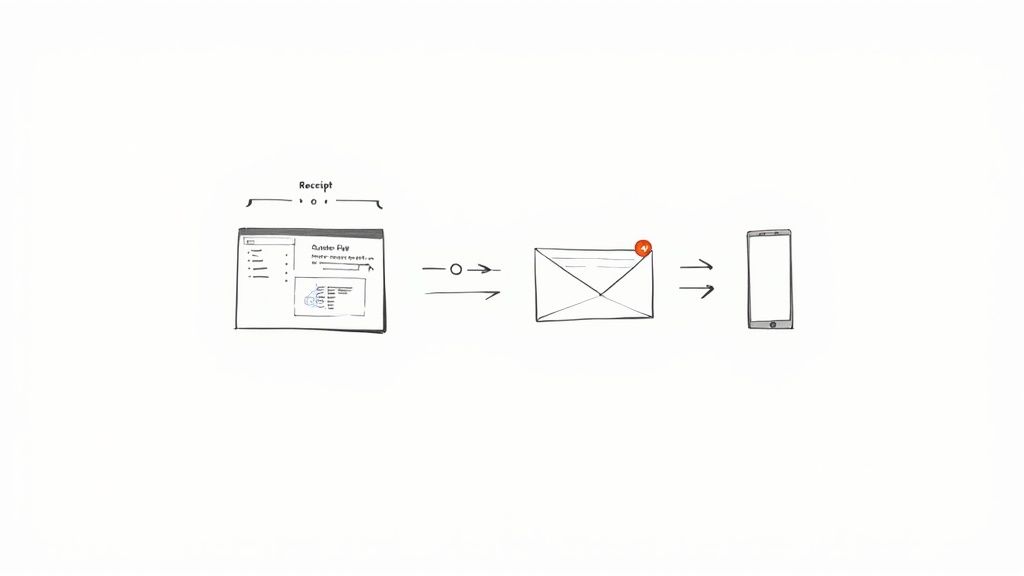
Alright, your branded receipt is looking sharp and ready to go. The last piece of the puzzle is getting it into your customer's hands.
But before you click "send," always hit that preview button. Seriously, this is your final chance to spot a rogue typo or a math error. A quick once-over now can save you from a confusing email thread with your customer later. Think of it as your pre-flight check.
Once you're happy with how everything looks, it's time to decide how you'll deliver it. Most online receipt makers let you fire it off directly via email, which is usually the quickest and easiest path for everyone.
Choosing Your Delivery Method
You can also download the receipt as a high-quality PDF. I find this is a great option if the customer wants a file they can easily store, or if you need to bundle it with other project documents. Some tools even give you a secure, shareable link, which is handy for sending a quick text.
My personal tip is to always download a PDF for your own records, even if you email it directly from the tool. Having a local backup gives you peace of mind and makes your own bookkeeping process much smoother.
When you do email the receipt, don't just attach the file and call it a day. A little extra touch goes a long way.
- Write a clear subject line: Something like "Your Receipt from [Your Business Name] - Order #12345" is perfect. It's easy to spot and simple for your customer to search for later.
- Include a brief, friendly message: A simple "Hi [Customer Name], thank you for your purchase! Your receipt is attached." reinforces a positive experience.
This small gesture is the final handshake of the transaction. It wraps things up on a professional, organized note and shows you care about the details from start to finish.
Got Questions About Making Receipts Online?
Jumping into online receipts for the first time usually brings up a few common questions. It’s smart to get these sorted out from the start so you can feel confident you’re handling your transactions the right way. Let's clear up some of the most frequent uncertainties.
Are Online Receipts Legally Valid?
This is a big one. People often wonder if a digital receipt has the same legal standing as a classic paper one.
The short answer is yes, absolutely. An online receipt is a legally valid proof of purchase, provided it contains all the necessary details. Think of it as the digital equivalent of its paper counterpart. As long as you include your business info, the customer's name, a unique receipt number, the date, a clear list of what was sold, and the total paid, you're golden. It’s perfectly fine for your bookkeeping and for your customers' records.
What's the Real Difference Between a Receipt and an Invoice?
It’s easy to get these two mixed up, but the distinction is all about timing.
An invoice is a request for payment. You send it before the customer pays to tell them what they owe. A receipt is a confirmation of payment that you provide after the money has been received. Simple as that.
How Do I Fix a Mistake on a Receipt?
We all make mistakes. If you spot an error on a receipt you've already sent, your first instinct might be to just edit it. The best practice, however, is to void the incorrect receipt entirely and issue a brand-new, corrected one. This keeps your financial trail clean and avoids any confusion down the line for both you and your client.
A crucial pro-tip: Always keep copies of every receipt you issue. Most online tools handle this for you automatically, creating a secure digital archive. This is a lifesaver for bookkeeping, tax season, or if you ever need to resolve a customer dispute.
To wrap things up, here are the key points to remember:
- Legally Sound: Digital receipts are completely valid as long as they have the right info.
- Invoice vs. Receipt: An invoice asks for payment; a receipt confirms it was made.
- Fixing Errors: Don't just edit. Void the old receipt and issue a new one.
- Keep Records: Always, always save a digital copy for your own files.
Ready to create a professional receipt in just a few clicks? With ReceiptMake, you can pick from over 100 templates and generate the perfect receipt with no sign-ups or hidden fees. Try the free receipt generator on ReceiptMake.com and see for yourself how simple it is.
Article created using Outrank
